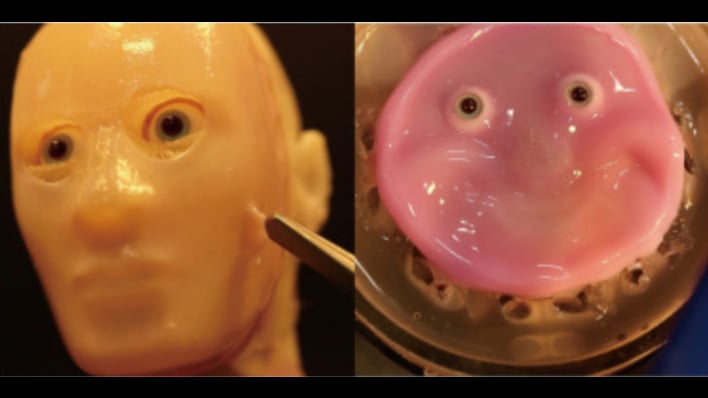
A group of Japanese scientists have conjured up a way to attach living skin to robot faces to make them more lifelike. The skin equivalent is a “living skin model composed of cells and extracellular matrix” which is said to be “an ideal covering for robots due to its biological functionalities.”
As artificial intelligence continues to advance, scientists and robotic engineers are developing humanoid robots to take full advantage of the technology. Companies such as Figure, Tesla, and Boston Dynamics are working on developing robots that mimic humans in work environments. In order to make these robots more lifelike, scientists have been looking into techniques that will bring the robots to life with a smile. That is just what a group of Japanese scientists believe they have developed.
The scientists recently published a paper citing their work surrounding a perforation-type anchor that is proposed to adhere living skin to robotic surfaces. According to the paper, the proposed anchors mimic human skin ligaments by gelling skin tissue via perforations. The method allows the living skin to be used as 3D facial molds and 2D skin coverings for robots.
The researchers remarked the technology could pave the way for creating more realistic, moving humanoid robots with self-healing skin that does not easily rip or tear. They added that the skin is even capable of repairing itself if cut. While the thought of self-healing skin on robots sounds incredible, the process of attaching it proved to be an arduous task. The researchers tried using mini hooks as anchors, but that ended up damaging the skin. The solution lied in perforation-type anchors.
In order to highlight the versatility of the perforation-type anchors in three-dimensional coverage applications, the scientists covered a 3D facial mold with an intricate surface structure with skin equivalent using the anchors. They also constructed a robotic face covered with dermis equivalent, able to express smiles, with actuation through perforation-type anchors. The results introduce an approach to adhere and actuate skin equivalents with perforation-type anchors with the potential for advancing biohybrid robotics.
“By mimicking human skin-ligament structures and by using specially made V-shaped perforations in solid materials, we found a way to bind skin to complex structures,” explained lead researcher Prof Shoji Takeuchi. “Another important challenge is creating human-like expressions by integrating sophisticated actuators, or muscles, inside the robot.”
While making humanoid robots more lifelike is great and all, the new tech could also be used in the cosmetics industry. One experiment made the smaller robot face smile for one month. The results proved interesting, as the scientists found they could replicate the formation of expression wrinkles in the skin.
“Being able to recreate wrinkle formation on a palm-sized laboratory chip can simultaneously be used to test new cosmetics and skincare products that aim to prevent, delay or improve wrinkle formation,” explained Michio Kawai, who performed the work while at the University of Tokyo.
The next challenge the scientists face with the living skin is the lack of sensing functions and absence of blood vessels to supply nutrients and moisture. The lack of these means the skin cannot survive for long periods of time in the air. Kawai remarked, “To address these issues, incorporating neural mechanisms and perfusion channels into the skin tissue is the current challenge.”
